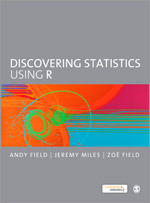Discovering Statistics Using R
- Andy Field - University of Sussex, UK
- Jeremy Miles - RAND Corporation, USA
- Zoë Field - University of Sussex, UK
Keeping the uniquely humorous and self-deprecating style that has made students across the world fall in love with Andy Field's books, Discovering Statistics Using R takes students on a journey of statistical discovery using R, a free, flexible and dynamically changing software tool for data analysis that is becoming increasingly popular across the social and behavioural sciences throughout the world.
The journey begins by explaining basic statistical and research concepts before a guided tour of the R software environment. Next you discover the importance of exploring and graphing data, before moving onto statistical tests that are the foundations of the rest of the book (for example correlation and regression). You will then stride confidently into intermediate level analyses such as ANOVA, before ending your journey with advanced techniques such as MANOVA and multilevel models. Although there is enough theory to help you gain the necessary conceptual understanding of what you're doing, the emphasis is on applying what you learn to playful and real-world examples that should make the experience more fun than you might expect.
Like its sister textbooks, Discovering Statistics Using R is written in an irreverent style and follows the same ground-breaking structure and pedagogical approach. The core material is augmented by a cast of characters to help the reader on their way, together with hundreds of examples, self-assessment tests to consolidate knowledge, and additional website material for those wanting to learn more.
Given this book's accessibility, fun spirit, and use of bizarre real-world research it should be essential for anyone wanting to learn about statistics using the freely-available R software.
Supplements
I ordered this book because I was considering in switching from SPSS to R for my course on epidemiology and statistics. I may decide to change to R in the next couple of years, in which case 'Discovering Statistics Using R' would be a good choice of text book.
We will stick with the SPSS version of the text. Good to see this though.
I strongly recommand this book to all my bachelor and master students, additionally to German books. In my opinion, Andy Field covers a wide range of complicated mathematical procedures in an "easy to understand" way, providing examples and code - making it fun to learn statistics.
Discovering Statistics using R is at least as good as its cousin
Discovering Statistics using SPSS!
The book offers excellent examples and illustrations, but I'm afraid that it's too specialized for my journalism and mass commuication students.
Ahmed Al-Rwi
Have already recommended this book to my MA students who are doing their research. Reading the book has helped me to discuss statistics with my Ma students when discussing statistics in their research work.
An excellent guide to SPSS usage for both our undergraduate and postgraduate students. This has become a standard for the field of sport science. However, although complex in the areas that are covered, not much is presented in the rather subjective area of the finer decision making.
This is proving to be an essential resource given the expense of SPSS. Andy Field is always great value and his writing style most accessible.
I have liked Field's approach for quite a while now. His explanations are clear and detailed enough to satisfy those who will be using statistical techniques in their terminal career. The only hesitation that I had in adopting his book was that I use R in the classroom. We teach a lot of students who will be going into nonprofit groups so the more expensive SAS and PASW are poor investments for them.
Now that this text is available, I am delighted to begin using it in the upcoming semester.
A very nice handbook, but the application R is too complex for our lecturers in the current open souce state it is in.. The handbook didn't change that.
For those PhD students and others with great interest of statistics.









